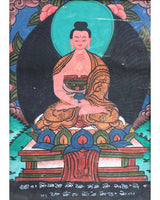
Amitabha Buddha Thangka | Spiritual Gift

100% AUTHENTIC

HANDMADE

FREE SHIPPING
Amitabha Buddha Thangka
About Thangka
Our thangka is a handpainted Tibetan art done using traditional methods. It is a unique piece created using genuine 24K gold and natural stone colors.
Introduction to Amitabha Buddha Thangka
This thangka painting of Amitabha Buddha was collected in the early 1990s in Kathmandu. It's a good size for a traveling practitioner or for anyone who would like to carry the thangka around easily. It's been mounted on a gorgeous hand weaved flower-patterned Khadi brocade.
Amitabha Buddha is red in color and he is seated in a meditative posture; hence his mudra is called ‘ dhyana mudra . His two palms are joined together with the right on the left, two thumbs of both hands touching each other. An Alms bowl is between his two palms. Here the hand gesture, representing meditative equipoise, represents the unity of wisdom and compassion.
Through his knowledge of discriminate wisdom, a bodhisattva understands the empty nature of all sentient beings and develops great compassion for them. This is the dhyana or meditation of Buddha Amitabha.
His color is red , symbolizing the fires of desire . When a Boddhisattva understands the discriminative wisdom of Amitabha Buddha he can use even the fires of desire on the path to Enlightenment . His symbol is lotus , representing purity . Though he himself is untainted by the evils of samsara , he nevertheless takes birth in samsara for the benefit of the sentient beings .
------------------------------------------------------------------
Size with Brocade: 22" / 56 cm (width) x 27"/ 59 cm (height)
Canvas Size : 11" / 28 cm (width) x 13"/ 33 cm (height)
Materials: Cotton Canvas, Acrylic Colors, Genuine 24K Gold
------------------------------------------------------------------
THIS THANGKA IS HAND-PAINTED IN THE TRADITIONAL STYLE AND THE QUALITY IS HIGH
How can Thangka benefit us?Thangkas, which were formerly utilized as teaching aids, are now used as a meditation technique to assist in moving one closer to enlightenment. During rituals and ceremonies, devotional images serve as the focal point and frequently serve as a conduit for prayers and requests.
Shipping & Returns
Row content
Compatibility
Row content











